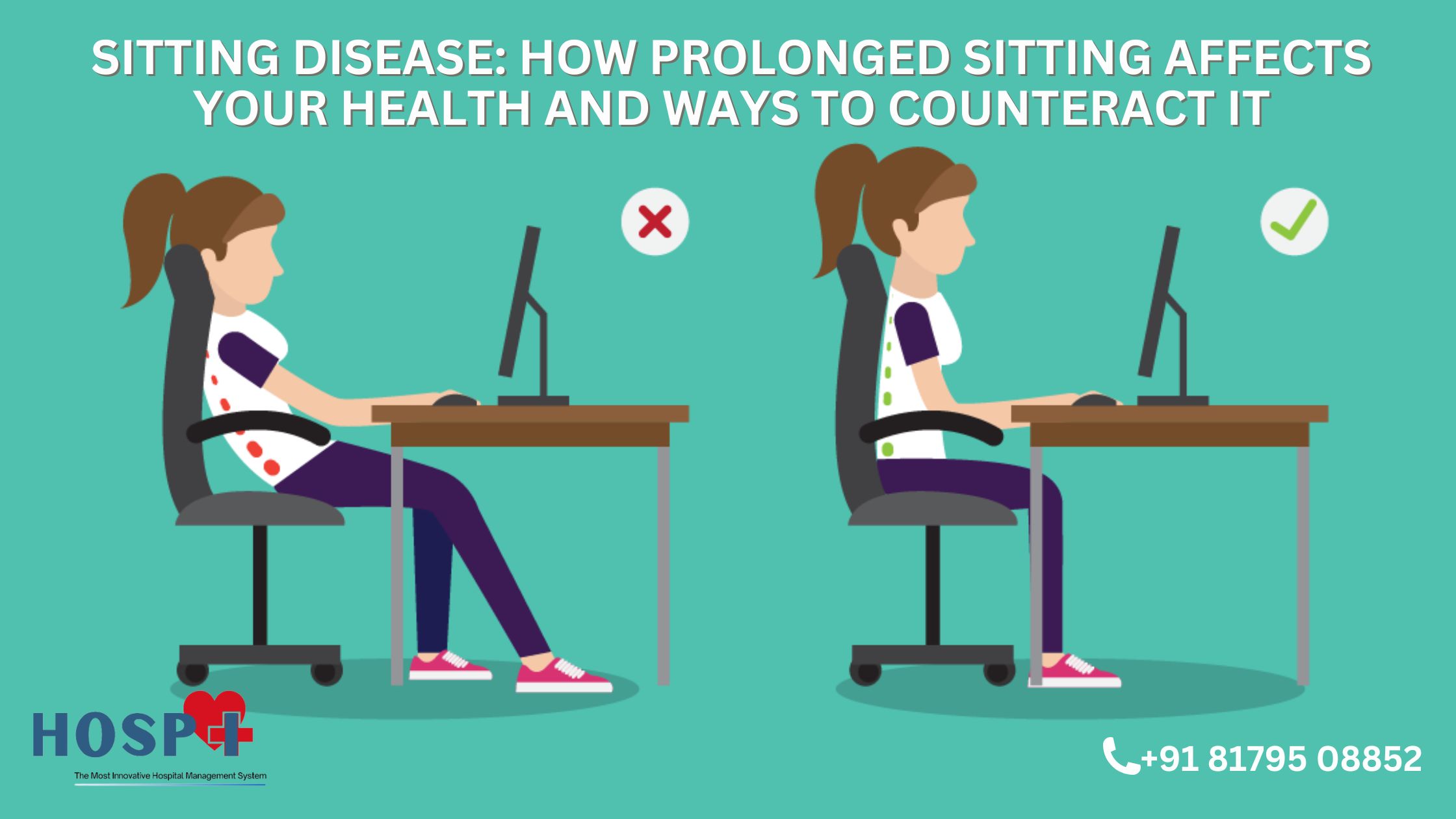Table of Contents
In today’s fast-paced world, sedentary lifestyles have become increasingly common due to the rise of desk jobs, technology use, and prolonged screen time. Prolonged sitting, which has become a hallmark of modern life, might seem harmless at first glance, but its impact on our health is far-reaching and concerning. This article delves into the various ways in which prolonged sitting affects your health and provides insights into mitigating its negative consequences.
The Sedentary Lifestyle Epidemic
Before delving into the effects of prolonged sitting, it’s important to understand the extent of the sedentary lifestyle epidemic. Research shows that the average person spends a significant portion of their day sitting, whether it’s in front of a computer at work, during commutes, or while watching TV at home. This shift towards inactivity has serious implications for our well-being.
Physical Health Implications
- Muscle Degeneration: Prolonged sitting can lead to muscle atrophy, especially in the muscles of the lower body. When muscles are not engaged regularly, they weaken over time, leading to decreased muscle mass and strength.
- Weight Gain and Obesity: A sedentary lifestyle is closely linked to weight gain and obesity. Sitting for long periods burns fewer calories than standing or engaging in physical activities, contributing to excess calorie intake and weight gain.
- Cardiovascular Risks: Sitting for extended periods has been associated with an increased risk of cardiovascular diseases. It can lead to higher blood pressure, elevated cholesterol levels, and a greater likelihood of developing heart-related issues.
- Diabetes: Prolonged sitting is linked to an increased risk of type 2 diabetes. Insulin resistance, a key factor in diabetes development, is exacerbated by prolonged periods of inactivity.
- Poor Posture: Sitting for long hours often results in poor posture. This can lead to musculoskeletal problems, including back, neck, and shoulder pain.
Impact on Mental Health
- Mood Disturbances: Sedentary behavior can negatively affect mental health by contributing to mood disturbances, including increased feelings of anxiety and depression.
- Cognitive Decline: Research suggests that prolonged sitting might be associated with cognitive decline and a higher risk of neurodegenerative diseases. Physical activity is known to support brain health and cognitive function.
Mitigating the Effects
- Regular Breaks: Taking frequent breaks to stand up, stretch, and move around can significantly reduce the negative effects of prolonged sitting. Set a timer to remind yourself to stand up and move for a few minutes every hour.
- Incorporate Movement: Finding ways to incorporate movement into your daily routine is crucial. This could include walking or cycling to work, using a standing desk, or opting for active transportation whenever possible.
- Exercise Regimen: Engage in regular exercise to counteract the effects of prolonged sitting. Aim for 150 minutes of moderate-intensity aerobic activity each week or 75 minutes of vigorous-intensity activity.
- Ergonomic Workspace: If your job requires sitting for long periods, ensure your workspace is ergonomic. Use an adjustable chair and computer setup to promote good posture and reduce strain.
- Mindful Screen Time: Limit screen time during leisure hours and engage in activities that encourage movement and social interaction.
Creating a Healthy Balance
As awareness about the perils of prolonged sitting grows, individuals and organizations alike are taking steps to create a healthier balance between sedentary activities and physical movement.
1. Workplace Wellness Initiatives: Many employers are recognizing the importance of employee well-being and are implementing workplace wellness initiatives. These may include standing desk options, on-site fitness facilities, and wellness programs that encourage regular physical activity.
2. Active Commuting: If feasible, consider adopting an active commuting routine. Walking, biking, or using public transportation that involves walking can help you incorporate more movement into your daily routine.
3. Social Interaction: Incorporating physical activities into social interactions can make them more enjoyable and beneficial. Instead of meeting friends for coffee, consider going for a walk or playing a sport together.
4. Hobbies and Recreation: Engaging in hobbies or recreational activities that involve movement can help break up periods of prolonged sitting. Whether it’s dancing, gardening, or playing a musical instrument, these activities can have positive effects on your physical and mental well-being.
5. Family Time: Encourage your family members to join you in physical activities. Family outings that involve hiking, playing outdoor games, or simply taking a walk together can foster healthier habits for everyone.
6. Mindful Sitting: While avoiding prolonged sitting is ideal, it’s not always possible, especially in certain work settings. In such cases, practicing mindful sitting can help. Ensure your posture is correct, take short breaks to stand and stretch, and make a conscious effort to engage your muscles even while seated.
7. Stay Hydrated: Drinking enough water throughout the day can prompt you to take more breaks. Use this opportunity to stand, stretch, and move around.
8. Gradual Changes: If you’re transitioning from a highly sedentary lifestyle, it’s important to make gradual changes. Setting unrealistic goals can lead to burnout or injury. Start with small, manageable adjustments and build on them over time.
9. Tracking Progress: Utilize fitness trackers or apps to monitor your daily activity levels. Tracking your steps, standing time, and exercise routines can help you stay accountable and motivated.
10. Consulting Professionals: If you have existing health concerns or conditions, it’s advisable to consult with a healthcare professional before making significant changes to your routine. They can provide personalized recommendations and ensure your approach aligns with your health needs.
A Future of Well-Being
Recognizing the impact of prolonged sitting on health and taking proactive steps to counteract it can pave the way for a healthier and more fulfilling life. While the demands of modern life may seem conducive to sedentary behavior, our well-being should remain a priority. By fostering a culture of movement and making conscious choices to minimize prolonged sitting, we can collectively create a future where well-being thrives.
Sustaining a Movement-Focused Lifestyle
Maintaining a movement-focused lifestyle requires commitment and consistency. Here are some additional strategies and tips to help you sustain positive habits and keep the detrimental effects of prolonged sitting at bay:
1. Goal Setting: Set realistic goals for your daily activity level. Whether it’s achieving a certain number of steps, dedicating a specific amount of time to exercise, or reducing your total sitting time, having clear goals can keep you motivated.
2. Variety in Exercise: Incorporate a variety of exercises into your routine. This not only prevents boredom but also engages different muscle groups and provides holistic benefits to your body.
3. Accountability: Partner up with a friend or family member who shares your health goals. Having someone to exercise with or check in on your progress can boost motivation and accountability.
4. Mind-Body Practices: Activities like yoga and Pilates can be particularly effective in counteracting the effects of prolonged sitting. They focus on posture, flexibility, and balance, helping to alleviate muscle imbalances and tension.
5. Stretching: Regular stretching can improve flexibility and reduce the risk of muscle stiffness from sitting. Incorporate dynamic stretches throughout the day and static stretches after exercise sessions.
6. Hydration Routine: Use hydration breaks as an opportunity to stand, stretch, and move. Staying hydrated not only supports your physical health but also prompts movement breaks.
7. Meal Choices: Opt for healthy meals and snacks that fuel your body and provide sustained energy. A balanced diet can contribute to your overall vitality and motivation to stay active.
8. Sleep Quality: Prioritize quality sleep. A well-rested body is more inclined to engage in physical activities and resist sedentary behaviors.
9. Regular Check-Ins: Periodically assess your progress and make adjustments as needed. This could involve tweaking your exercise routine, setting new goals, or exploring new activities.
10. Mindfulness and Stress Management: Practice mindfulness and stress-reduction techniques. Stress can lead to increased sitting time and unhealthy habits. Techniques like meditation and deep breathing can help manage stress and promote a healthier lifestyle.
11. Educate and Inspire: Share your journey with friends, family, or even on social media. Your experience and progress can inspire others to make positive changes in their own lives.
12. Professional Guidance: Consider seeking guidance from fitness professionals, physical therapists, or nutritionists. They can provide personalized recommendations tailored to your individual needs and goals.
A Lifetime Commitment to Health
Incorporating movement into your daily life is not a temporary fix but a lifelong commitment to your health and well-being. By making conscious choices to reduce sitting time and engage in regular physical activity, you’re investing in your future vitality and quality of life. Remember that every step you take, every break you stand up for, and every active choice you make contributes to a healthier, happier you.
Embracing Change for a Healthier Tomorrow
The effects of prolonged sitting on health are a wake-up call to the urgent need for change. As we navigate a world dominated by screens and sedentary activities, it’s crucial to redefine our relationship with movement. By choosing an active lifestyle, we’re taking a proactive stance against the negative consequences of prolonged sitting. Let this knowledge empower you to make conscious decisions that prioritize your health and well-being. Your body and mind will thank you for years to come as you savor the benefits of a life well-lived—one that celebrates movement, vitality, and holistic wellness.
Conclusion of How Prolonged Sitting Affects Your Health
The detrimental effects of prolonged sitting on health are undeniable. From physical issues like muscle degeneration and obesity to mental health concerns like mood disturbances, the consequences are broad-reaching. As we navigate a technology-driven world, it’s essential to be mindful of our sedentary habits and make conscious efforts to incorporate movement into our daily lives. By doing so, we can safeguard our health and well-being for the long term.
To read more articles like this, visit: https://hospi.info/blog/



